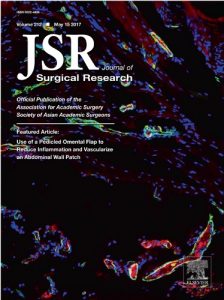
The work of McGowan Institute for Regenerative Medicine director William Wagner, PhD, and colleagues is featured on the cover of the May 15, 2017, issue of the publication, Journal of Surgical Research. The corresponding article is entitled “Use of a pedicled omental flap to reduce inflammation and vascularize an abdominal wall patch.” The co-authors are Takafumi Uchibori, MD; Keisuke Takanari, MD, PhD; Ryotaro Hashizume, MD, PhD; Nicholas J. Amoroso, PhD; and Yuzuru Kamei, MD, PhD.
The abstract reads:
Background: Although a variety of synthetic materials have been used to reconstruct tissue defects, these materials are associated with complications such as seromas, fistulas, chronic patient discomfort, and surgical site infection. While alternative, degradable materials that facilitate tissue growth have been examined. These materials can still trigger a foreign body inflammatory response that can lead to complications and discomfort.
Materials and methods: In this report, our objective was to determine the effect of placing a pedicled omental flap under a biodegradable, microfibrous polyurethane scaffold serving as a full-wall thickness replacement of the rat abdominal wall. It was hypothesized that the presence of the omental tissue would stimulate greater vascularization of the scaffold and act to reduce markers of elevated inflammation in the patch vicinity. For control purposes, a polydimethylsiloxane sheet was placed as a barrier between the omental tissue and the overlying microfibrous scaffold. Both groups were sacrificed 8 weeks after the implantation, and immunohistological and reverse transcription polymerase chain reaction (RT-PCR) assessments were performed.
Results: The data showed omental tissue placement to be associated with increased vascularization, a greater local M2/M1 macrophage phenotype response, and mRNA levels reduced for inflammatory markers but increased for angiogenic and anti-inflammatory factors.
Conclusions: From a clinical perspective, the familiarity with utilizing omental flaps for an improved healing response and infection resistance should naturally be considered as new tissue engineering approaches that are translated to tissue beds where omental flap application is practical. This report provides data in support of this concept in a small animal model.
The journal cover photo caption reads: Border between scaffold and omentum. Immunostaining for von Willebrand factor (vWF; red), alpha-smooth muscle actin (SMA; green), and Hoechst (blue) for samples from the omentum 8-wk group. Scale bars = 100 μm.
